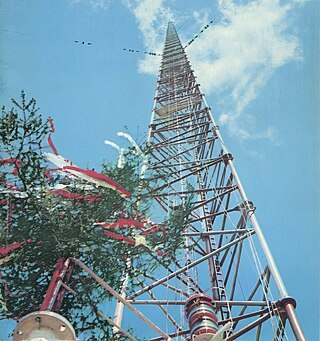
The Warsaw Radio Mast was a radio mast located near Gąbin, Poland, and the world's tallest structure at 2,120 ft from 1974 until its collapse on 8 August 1991. The mast was designed for extreme height in order to broadcast Communist propaganda around the world, including to the remotest areas such as Antarctica. As of 2023, it was the third-tallest structure ever built, after the Burj Khalifa tower in the United Arab Emirates in 2009, and Merdeka 118 tower in Malaysia in 2022.

The Mühlacker Broadcasting Transmission Facility is a radio transmission facility near Mühlacker, Germany, first put into service on November 21, 1930. It uses two guyed steel tube masts as aerials and one guyed steel framework mast, which are insulated against ground. It has two transmission aerials for shortwave and one free standing steel framework tower for directional radio services. The shortwave transmitter was shut off on October 19, 2004. The medium wave transmitter was switched off in January 2012.

The Langenberg transmission tower is a broadcasting station for ananlog FM Radio and Digital-TV signals. It is located in Langenberg, Velbert, Germany and owned and operated by Westdeutscher Rundfunk, WDR.
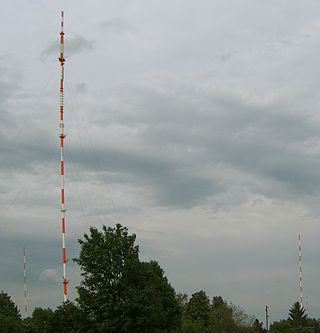
The Transmitter Hamburg-Billstedt is a broadcasting facility in Hamburg-Billstedt, established in 1934. It is owned and operated by the Norddeutscher Rundfunk public broadcasting service, but open to competitors, too.

The Transmitter Ismaning was a large radio transmitting station near Ismaning, Bavaria, Germany. It was inaugurated in 1932. From 1932 to 1934 this transmitter used a T-antenna as transmitting antenna, which was spun between two 115-metre-high free-standing wooden lattice towers, which were 240 metres apart. As this antenna had an unfavourable vertical radiation pattern, which produced much skywave resulting in a too small fading-free reception area at night, in 1934 a new antenna was installed. Therefore, one of the towers was dismantled and rebuilt on a 39-metre-high (128 ft) wooden lattice base. While this work took place, an L-Antenna was used, which was spun between the other tower and a small auxiliary wooden tower. It became defunct in 1977 and was destroyed in 1983.
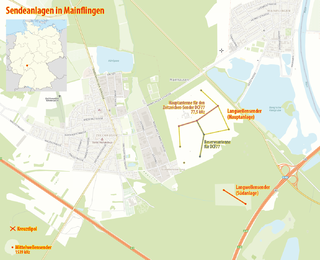
The Mainflingen mediumwave transmitter is a mediumwave transmission facility south of the A3 motorway near Mainflingen, Hesse, Germany. Mainflingen was the first mediumwave transmitter for the radio station Deutschlandfunk. It went into service in 1962 with a transmission power of 50 kW, on a frequency of 1538 kHz, at the upper end of the mediumwave band. This frequency has a bad groundwave propagation and therefore a low range at daytime, but an excellent skywave propagation with a long range at night.
The Monte Ceneri transmitter was first established as the nationwide medium-wave radio transmission station for Italian-speaking Switzerland in 1933. Located on Monte Ceneri in Ticino, it broadcast on a frequency of 558 kHz.
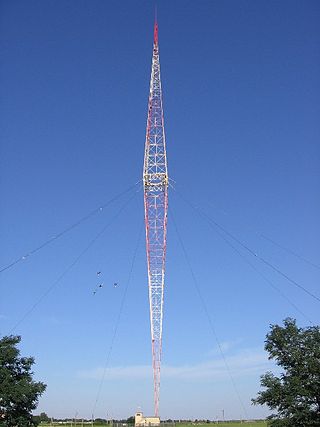
The Lakihegy Tower is a 314-metre-high (1,031 ft) radio mast at Szigetszentmiklós-Lakihegy in Hungary. The Blaw-Knox type tower was built in 1933 and was one of Europe's tallest structures at the time of construction. It was designed to provide broadcast coverage for Hungary with a 120 kW transmitter. It was built for the purpose of transmitting the radio station "Budapest I.", which it served until 1977.

The Mediumwave transmitter Lopik was a medium wave broadcasting facility near Lopik in the Netherlands. It was constructed in 1938 and closed down on 1 September 2015. Its last use was to transmit the Dutch language edition of Radio Maria on 675 kHz. The aerial consisted of a 196-metre (643') guyed steel framework mast, which was insulated against ground.
The mediumwave transmitter Flevoland was a broadcasting facility for medium wave near Zeewolde in the province of Flevoland, Netherlands, situated at 5°25′ E and 52°23′ N. It has been used for broadcasting on 747 kHz and 1008 kHz with a nominal power of 400 kilowatts. As aerial two guyed steel framework masts with a height of 195 metres are used, which form an anti-fading aerial. These masts are grounded and carry a cage aerial, which is upperward the separation insulator, separating the masts in a height of 95 metres in two parts, connected toward the mast construction. The radiation diagram is directional, with a maximum gain of 4 dB in South-Eastern direction, to compensate for the variation in electrical admittance of terrain in the Netherlands.

The Żórawina radio transmitter is a facility for FM transmission at Żórawina, south of Wrocław. It was established in 1932 as "Reichssender Breslau" and used as an antenna tower. Originally it was a 140-metre-tall free-standing lattice tower built of wood, on which a wire antenna was hung up. On the top of the tower there was an octagonal ring of bronze with a diameter of 10.6 metres for electrical lengthening of the antenna.

The Hirschlanden transmitter was a facility of the Deutsche Telekom AG for mediumwave broadcasting south of Ditzingen-Hirschlanden situated at 48°49'47" N and 9°02'15" E.

The Wiederau transmitter is the oldest broadcasting facility in Saxony. It is located near Wiederau, a village which is part of the municipality of Pegau, and is used for medium-wave, FM and Television broadcasting.
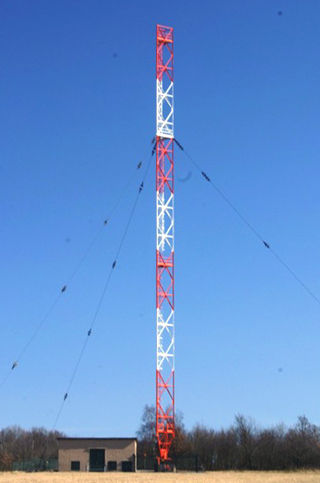
Marnach transmitter was a broadcasting facility of RTL near Marnach in the commune of Clervaux, in northern Luxembourg. The Marnach transmitter was built in 1955 for improving the transmission of the English-speaking program on 1439 kHz, which was transmitted from 1951 with an omnidirectional antenna from Junglinster, to the British Isles and for a better transmission on this frequency to Germany at daytime. Therefore, it was given a directional antenna with a switchable directional characteristic pointing North-northeast towards the Rhine-Ruhr area, Germany's most populated area, and West-northwest in the direction of the UK. This antenna was implemented in form of a directional antenna consisting of three ground-fed 105-metre (350') tall guyed mast antennas arranged in the form of an isosceles triangle with a 90 degree angle. As transmitters, two 100 kW units switched in parallel were used when it went in service in December 1955.

Dillberg transmitter is a transmitting facility of the Bavarian Broadcasting Company on the 595-metre-high Dillberg mountain west of Neumarkt in der Oberpfalz, Bavaria, Germany. Dillberg transmitter went into service in 1955 for serving the area of Nuremberg with TV and FM radio programmes from a 198-metre-tall guyed mast.

Ravensburg-Horgenzell transmitter was a mediumwave broadcasting facility of Deutsche Telekom used for transmitting the program of Deutschlandfunk on the area of community Horgenzell northwest of Ravensburg in Baden-Württemberg. It was inaugurated on August 23, 1951, and used until 1959 for transmitting the radio programme of SWF with a transmission power of 40 kW on 1538 kHz. As antenna, it used a 120 metre tall guyed ground-fed lattice steel mast radiator at 47°47'10" N and 9°31'16" E.

Weiskirchen transmitter, is a mediumwave broadcasting tower in Weiskirchen, Germany. It is the property of Hessischer Rundfunk. It was built in 1967
Hoher Meissner transmitter is a facility for FM and TV broadcasting on Hoher Meissner mountain in Northern Hesse. The transmitter was inaugurated in 1952.

Warszewo transmitter is a radio broadcasting facility at Warszewo, Szczecin, a suburb of Szczecin, Poland.
Col de la Madone transmitter is a very large broadcasting centre operated by Radio Monte Carlo north of Fontbonne, near Nice and Monaco, in France. It was established in 1965 and was used until completion of Roumoules radio transmitter for longwave broadcasting, using 3 320 metres tall guyed mast radiators, which do not exist any more. It was used for broadcasting on 702 kHz and 1467 kHz. Both antennas consist of 2 guyed mast radiators insulated against ground. The masts of the antenna for 1467 kHz are 101 metres tall and oriented in North-South direction. The masts of the antenna for 702 kHz are oriented in East-West direction pointing towards Milan, as it is used for transmitting a radio program in Italian language toward Italy. The western mast of this antenna, which acts as reflector, has a height of 250 metres while the eastern mast which is the radiator is 215 metres taller. A bit souther, there is close to a military radar site a centre for FM-broadcasting and on Mount Angel there is a 146 metres tall partially guyed tower, which consists of a grounded lattice tower as basement and a guyed mast radiator insulated against ground as top. It was built in 1946 and first used for mediumwave broadcasting, but is today used for TV-broadcasting. Nearby there is also the shortwave transmitter of RMC with several dipole walls.
















